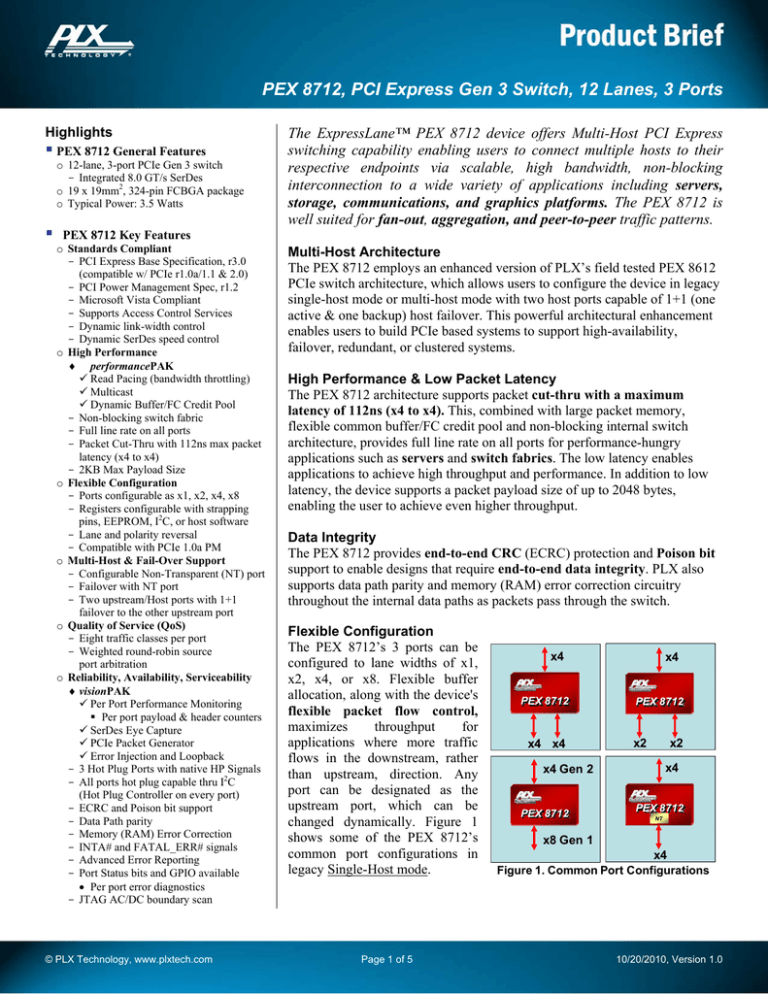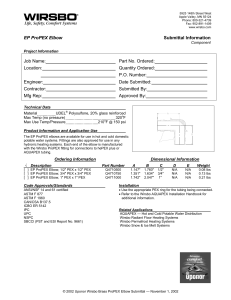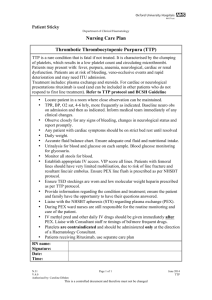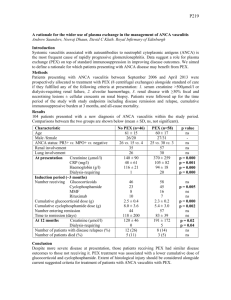
PEX 8712, PCI Express Gen 3 Switch, 12 Lanes, 3 Ports
Highlights
PEX 8712 General Features
o 12-lane, 3-port PCIe Gen 3 switch
- Integrated 8.0 GT/s SerDes
o 19 x 19mm2, 324-pin FCBGA package
o Typical Power: 3.5 Watts
The ExpressLane™ PEX 8712 device offers Multi-Host PCI Express
switching capability enabling users to connect multiple hosts to their
respective endpoints via scalable, high bandwidth, non-blocking
interconnection to a wide variety of applications including servers,
storage, communications, and graphics platforms. The PEX 8712 is
well suited for fan-out, aggregation, and peer-to-peer traffic patterns.
PEX 8712 Key Features
o Standards Compliant
- PCI Express Base Specification, r3.0
(compatible w/ PCIe r1.0a/1.1 & 2.0)
- PCI Power Management Spec, r1.2
- Microsoft Vista Compliant
- Supports Access Control Services
- Dynamic link-width control
- Dynamic SerDes speed control
o High Performance
♦ performancePAK
9 Read Pacing (bandwidth throttling)
9 Multicast
9 Dynamic Buffer/FC Credit Pool
- Non-blocking switch fabric
- Full line rate on all ports
- Packet Cut-Thru with 112ns max packet
latency (x4 to x4)
- 2KB Max Payload Size
o Flexible Configuration
- Ports configurable as x1, x2, x4, x8
- Registers configurable with strapping
pins, EEPROM, I2C, or host software
- Lane and polarity reversal
- Compatible with PCIe 1.0a PM
o Multi-Host & Fail-Over Support
- Configurable Non-Transparent (NT) port
- Failover with NT port
- Two upstream/Host ports with 1+1
failover to the other upstream port
o Quality of Service (QoS)
- Eight traffic classes per port
- Weighted round-robin source
port arbitration
o Reliability, Availability, Serviceability
♦ visionPAK
9 Per Port Performance Monitoring
Per port payload & header counters
9 SerDes Eye Capture
9 PCIe Packet Generator
9 Error Injection and Loopback
- 3 Hot Plug Ports with native HP Signals
- All ports hot plug capable thru I2C
(Hot Plug Controller on every port)
- ECRC and Poison bit support
- Data Path parity
- Memory (RAM) Error Correction
- INTA# and FATAL_ERR# signals
- Advanced Error Reporting
- Port Status bits and GPIO available
• Per port error diagnostics
- JTAG AC/DC boundary scan
© PLX Technology, www.plxtech.com
Multi-Host Architecture
The PEX 8712 employs an enhanced version of PLX’s field tested PEX 8612
PCIe switch architecture, which allows users to configure the device in legacy
single-host mode or multi-host mode with two host ports capable of 1+1 (one
active & one backup) host failover. This powerful architectural enhancement
enables users to build PCIe based systems to support high-availability,
failover, redundant, or clustered systems.
High Performance & Low Packet Latency
The PEX 8712 architecture supports packet cut-thru with a maximum
latency of 112ns (x4 to x4). This, combined with large packet memory,
flexible common buffer/FC credit pool and non-blocking internal switch
architecture, provides full line rate on all ports for performance-hungry
applications such as servers and switch fabrics. The low latency enables
applications to achieve high throughput and performance. In addition to low
latency, the device supports a packet payload size of up to 2048 bytes,
enabling the user to achieve even higher throughput.
Data Integrity
The PEX 8712 provides end-to-end CRC (ECRC) protection and Poison bit
support to enable designs that require end-to-end data integrity. PLX also
supports data path parity and memory (RAM) error correction circuitry
throughout the internal data paths as packets pass through the switch.
Flexible Configuration
The PEX 8712’s 3 ports can be
configured to lane widths of x1,
x2, x4, or x8. Flexible buffer
allocation, along with the device's
flexible packet flow control,
maximizes
throughput
for
applications where more traffic
flows in the downstream, rather
than upstream, direction. Any
port can be designated as the
upstream port, which can be
changed dynamically. Figure 1
shows some of the PEX 8712’s
common port configurations in
legacy Single-Host mode.
Page 1 of 5
x4
PEX 8712
x4 x4
x4
PEX 8712
x2
x2
x4
x4 Gen 2
PEX 8712
PEX 8712
NT
x8 Gen 1
x4
Figure 1. Common Port Configurations
10/20/2010, Version 1.0
PEX 8712, PCI Express Gen 3 Switch, 12 Lanes, 3 Ports
The PEX 8712 can also be configured in Multi-Host mode.
In Multi-Host mode, a virtual switch is created for each
host port and its associated
x4
x4
downstream ports inside the device.
The traffic between the ports of a
virtual switch is completely isolated
from the traffic in other virtual
PEX 8712
switches. With the PEX 8712 in
Multi-Host mode, users can choose
two ports as host/upstream ports and
x4
assign the remaining downstream
Figure 2. Multi-Host
port to the desired host. In this
Port Configuration
scenario, one of the hosts will serve
as a failover port which will not have a downstream port of
its own. If the primary host were to fail, the secondary host
would then take over this downstream port (see Figure 2).
The PEX 8712 also provides several ways to configure its
registers. The device can be configured through strapping
pins, I2C interface, host software, or an optional serial
EEPROM. This allows for easy debug during the
development phase, performance monitoring during the
operation phase, and driver or software upgrade.
Dual-Host & Failover Support
In Single-Host mode, the PEX 8712 supports a NonTransparent (NT) Port, which enables the
implementation of dual-host systems for redundancy and
host failover
Primary Host
Secondary Host
capability. The NT
CPU
CPU
port allows systems
to isolate host
memory domains by
Root
Complex
presenting the
processor subsystem
as an endpoint
NT
rather than another
PEX 8712
Non-Transparent
memory system.
Port
Base address
End
registers are used to
Point
translate addresses;
Figure 3. Non-Transparent Port
doorbell registers
are used to send interrupts between the address domains;
and scratchpad registers (accessible by both CPUs) allow
inter-processor communication (see Figure 3).
Multi-Host & Failover Support
In Multi-Host mode, PEX 8712 can be configured with
two upstream host ports, each with its own dedicated
downstream ports. The device can be configured for 1+1
© PLX Technology, www.plxtech.com
redundancy. The PEX 8712 allows the hosts to
communicate their status to each other via special doorbell registers. In failover mode, if a host fails, the host
designated for failover will disable the upstream port
attached to the failing host and program the downstream
ports of that host to its own domain. Figure 4a shows a two
host system in Multi-Host mode with two virtual switches
inside the device and Figure 4b shows Host 1 disabled
after failure and Host 2 having taken over all of Host 1’s
end-points.
Host 1
Host 2
PEX 8712
End
Point
Figure 4a. Multi-Host
Host 1
Host 2
PEX 8712
End
Point
Figure 4b. Multi-Host Fail-Over
Hot Plug for High Availability
Hot plug capability allows users to replace hardware
modules and perform maintenance without powering down
the system. The PEX 8712 hot plug capability feature
makes it suitable for High Availability (HA)
applications. All three ports include a Standard Hot Plug
Controller. If the PEX 8712 is used in an application
where one or more of its downstream ports connect to PCI
Express slots, each port’s Hot Plug Controller can be used
to manage the hot-plug event of its associated slot. Every
port on the PEX 8712 is equipped with a hot-plug
control/status register to support hot-plug capability
through external logic via the I2C interface.
SerDes Power and Signal Management
The PEX 8712 provides low power capability that is fully
compliant with the PCIe power management specification
and supports software control of the SerDes outputs to
allow optimization of power and signal strength in a
system. Furthermore, the SerDes block supports loop-back
modes and advanced reporting of error conditions,
which enables efficient management of the entire system.
Interoperability
The PEX 8712 is designed to be fully compliant with the
PCI Express Base Specification r2.0, and is backwards
compatible to PCI Express Base Specification r1.1 and
r1.0a. Additionally, it supports auto-negotiation, lane
reversal, and polarity reversal. Furthermore, the PEX
8712 is tested for Microsoft Vista compliance. All PLX
Page 2 of 5
10/20/2010, Version 1.0
PEX 8712, PCI Express Gen 3 Switch, 12 Lanes, 3 Ports
switches undergo thorough interoperability testing in
PLX’s Interoperability Lab and compliance testing at
the PCI-SIG plug-fest.
SerDes Eye Capture, Error Injection, SerDes Loopback,
and more.
Performance Monitoring
performancePAK™
Exclusive to PLX, performancePAK is a suite of unique
and innovative performance features which allows PLX’s
Gen 2 switches to be the highest performing Gen 2
switches in the market today. The performancePAK
features consists of the Read Pacing, Multicast, and
Dynamic Buffer Pool.
The PEX 8712’s real time performance monitoring allows
users to literally “see” ingress and egress performance on
each port as traffic passes through the switch using PLX’s
Software Development Kit (SDK). The monitoring is
completely passive and therefore has no affect on overall
system performance. Internal counters provide extensive
granularity down to traffic & packet type and even allows
for the filtering of traffic (i.e. count only Memory Writes).
Read Pacing
The Read Pacing feature allows users to throttle the
amount of read requests being made by downstream
devices. When a downstream device requests several long
reads back-to-back, the Root Complex gets tied up in
serving that downstream port. If that port has a narrow link
and is therefore slow in receiving these read packets from
the Root Complex, then other downstream ports may
become starved – thus, impacting performance. The Read
Pacing feature enhances performances by allowing for the
adequate servicing of all downstream devices.
SerDes Eye Capture
Users can evaluate their system’s signal integrity at the
physical layer using the PEX 8712’s SerDes Eye Capture
feature. Using PLX’s SDK, users can view the receiver
eye of any lane on the switch. Users can then modify
SerDes settings and see the impact on the receiver eye.
Figure 5 shows a screenshot of the SerDes Eye Capture
feature in the SDK.
Multicast
The Multicast feature enables the copying of data (packets)
from one ingress port to both egress ports in one
transaction allowing for higher performance in dualgraphics, storage, security, and redundant applications,
among others. Multicast relieves the CPU from having to
conduct multiple redundant transactions, resulting in
higher system performance.
Dynamic Buffer Pool
The PEX 8712 employs a dynamic buffer pool for Flow
Control (FC) management. As opposed to a static buffer
scheme which assigns fixed, static buffers to each port,
PLX’s dynamic buffer allocation scheme utilizes a
common pool of FC Credits which are shared by other
ports. This shared buffer pool is fully programmable by the
user, so FC credits can be allocated among the ports as
needed. Not only does this prevent wasted buffers and
inappropriate buffer assignments, any unallocated buffers
remain in the common buffer pool and can then be used
for faster FC credit updates.
visionPAK™
Another PLX exclusive, visionPAK is a debug diagnostics
suite of integrated hardware and software instruments that
users can use to help bring their systems to market faster.
visionPAK features consist of Performance Monitoring,
© PLX Technology, www.plxtech.com
Figure 5. SerDes Eye Capture
PCIe Packet Generator
The PEX 8712 features a full-fledged PCIe Packet
Generator capable of creating programmable PCIe traffic
running at up to Gen 3 speeds and capable of saturating a
x16 link. Using PLX’s Software Development Kit
(www.plxtech.com/sdk), designers can create custom
traffic scripts for system bring-up and debug. Fully
integrated into the PEX 8712, the Packet Generator proves
to be a very convenient on-chip debug tool. Furthermore,
the Packet Generator can be used to create PCIe traffic to
test and debug other devices on the system.
Page 3 of 5
10/7/2010, Version 1.0
PEX 8712, PCI Express Gen 3 Switch, 12 Lanes, 3 Ports
Error Injection & SerDes Loopback
Using the PEX 8712’s Error Injection feature, users can
inject malformed packets and/or fatal errors into their
system and evaluate a system’s ability to detect and
recover from such errors. The PEX 8712 also supports
Internal Tx, External Tx, Recovered Clock, and Recovered
Data Loopback modes.
Embedded Systems
The PEX 8712 is well suited for embedded applications as
well. Embedded applications, like the example shown in
Figure 8, commonly use a number of independent modules
for functions such as control plane processing, data
acquisition, or image processing to name a few
possibilities. Figure 8 represents an embedded system
utilizing a PEX 8612 to fan-out to two ASICs/FPGAs.
Applications
Suitable for host-centric as well as peer-to-peer traffic
patterns, the PEX 8712 can be configured for a wide
variety of form factors and applications.
ASIC/
FPGA
x4
CPU
CPU
CPU
CPU
x4
PEX 8712
x4
ASIC/
FPGA
Host Centric Fan-out
The PEX 8712, with its symmetric or asymmetric lane
configuration capability, allows user-specific tuning to a
variety of host-centric applications. Figure 6 shows a
server design where the PEX 8712 is being used to fan-out
to endpoints and PCI Express slots. Since the PEX 8712 is
compliant with PCIe Gen
CPU
CPU
PCH
Memory
1 and Gen 2 devices, the
CPU
CPU
PEX 8712 can also
PCI
x4
be used to bridge
SATA
x1s
Gen 1and Gen 2
PEX 8712
endpoints to
Gen 3 chipsets
x4
x4
Endpoint
and processors
(and vice versa).
PCIe Gen1, Gen2, or Gen3 slots
Figure 6. Host Centric Fan-Out
Memory
Figure 8. Embedded Systems
Fail-Over in Storage Systems with Multicast
The PEX 8712’s Multicast feature proves to be very useful
in storage systems. In the example shown in Figure 9, the
Multicast feature enables the PEX 8712 to copy data
coming from the host to two downstream ports (see yellow
traffic patterns) in one transaction as opposed to having to
execute two separate transactions to send data to the
backup chassis. By offloading the task of backing up data
onto the secondary system, processor and system
performance is enhanced.
Network Interface Cards
The PEX 8712 can also be utilized in communications
applications such as Network Interface Cards (NICs).
NICs can utilize the PEX 8712 for its fan-out capabilities.
In Figure 7, the PEX 8712 is uses x4 links on a Dual-port
10-Gigabit Ethernet (GE) NIC card links to connect the
host to the 10GE ports. The peer-to-peer communication
feature of the PEX 8712 allows the endpoints to
communicate with each other without any intervention or
management by the host.
CPU
CPU
CPU
CPU
Memory
Chipset
x4
PEX 8712
x4
x4
Dual-Port NIC
MAC/PHY
x4
PEX 8712
x4
10 GE
MAC/PHY
x4
PEX 8712
FC
Control
x4
FC
Control
PEX 8712
x4
FC
Control
x4
FC
Control
x4
8 Disk Chassis
Figure 7. 10GE NIC Fan-Out
© PLX Technology, www.plxtech.com
Backup Chassis
10 GE
8 Disk Chassis
Figure 9. Multicast in Storage Systems
Page 4 of 5
10/7/2010, Version 1.0
PEX 8712, PCI Express Gen 3 Switch, 12 Lanes, 3 Ports
Software Model
ExpressLane PEX 8712 RDK
From a system model viewpoint, each PCI Express port is
a virtual PCI to PCI bridge device and has its own set of
PCI Express configuration registers. It is through the
upstream port that the BIOS or host can configure the
other ports using standard PCI enumeration. The virtual
PCI to PCI bridges within the PEX 8712 are compliant to
the PCI and PCI Express system models. The
Configuration Space Registers (CSRs) in a virtual
primary/secondary PCI to PCI bridge are accessible by
type 0 configuration cycles through the virtual primary bus
interface (matching bus number, device number, and
function number).
Interrupt Sources/Events
The PEX 8712 switch supports the INTx interrupt message
type (compatible with PCI 2.3 Interrupt signals) or
Message Signaled Interrupts (MSI) when enabled.
Interrupts/messages are generated by PEX 8712 for hot
plug events, doorbell interrupts, baseline error reporting,
and advanced error reporting.
The PEX 8712 RDK (see Figure 10) is a hardware module
containing the PEX 8712 which plugs right into your
system. The PEX 8712 RDK can be used to test and
validate customer software, or used as an evaluation
vehicle for PEX 8712 features and benefits. The PEX 8712
RDK provides everything that a user needs to get their
hardware and software development started.
Software Development Kit (SDK)
PLX’s Software Development Kit is available for
download at www.plxtech.com/sdk. The software
development kit includes drivers, source code, and GUI
interfaces to aid in configuring and debugging the PEX
8712.
Both performancePAK and visionPAK are supported by
PLX’s RDK and SDK, the industry’s most advanced
hardware- and software-development kits.
Product Ordering Information
Part Number
PEX8712-AA80BC G
PEX8712-AA RDK
Description
12-Lane, 3-Port PCI Express Switch,
Pb-Free (19x19mm2)
PEX 8712 Rapid Development Kit
PLX Technology, Inc. All rights reserved. PLX, the PLX logo, ExpressLane,
Read Pacing and Dual Cast are trademarks of PLX Technology, Inc. All other
product names that appear in this material are for identification purposes only
and are acknowledged to be trademarks or registered trademarks of their
respective companies. Information supplied by PLX is believed to be accurate
and reliable, but PLX assumes no responsibility for any errors that may appear in
this material. PLX reserves the right, without notice, to make changes in product
design or specification.
Visit www.plxtech.com for more information.
Figure 10. PEX 8712 RDK
Development Tools
PLX offers hardware and software tools to enable rapid
customer design activity. These tools consist of a hardware
module (PEX 8712 RDK), hardware documentation
(available at www.plxtech.com), and a Software
Development Kit (also available at www.plxtech.com).
© PLX Technology, www.plxtech.com
Page 5 of 5
10/7/2010, Version 1.0







